
In 1845, the Journal des sciences militaires1 described a project by a contributor to the United Service Magazine which fell halfway between railway artillery and armoured trains. He proposed defending the coastlines of the United States by means of a ‘railway wide enough to allow the passage of wagons of large dimensions, similar as far as possible to the deck of a warship, open on the landward side and armed with cannons pointing out to sea’. The wagons were to be protected by an armoured side pierced by loopholes. A wall or dike of stones would be built to protect the railroad. Fortified stations set every 20 miles would enable the artillery wagons to intervene at any point on the coast within a maximum delay of fifteen minutes.
(For the armoured rail vehicles used by the South during the Civil War, see the chapter on the Confederate States of America)
From the very beginning of the war, the employment of railway batteries in the form of guns placed at the head of trains came into use at several different locations on the front line, either on the initiative of the high command or of especially inventive local commanders. For example, in May 1861, in order to protect the network of the Baltimore & Ohio Railroad, Union General McClellan ordered the mounting of artillery at the head of troop trains. The Dictator was another example, made famous during the siege of Petersburg between June 1864 and March 1865. This 13in coast-defence mortar lacked armour protection, and fired from a simple platform wagon. However, in this chapter we will confine ourselves to an examination of those armoured artillery batteries which demonstrated the modern aspects of the American Civil War, and which provided the inspiration for similar construction in many future conflicts, beginning with the Franco-Prussian War, until surpassed in ingenuity during the Boer War.
During the very first days of the war the Federal Government ordered the construction of an armoured wagon to protect the track workers on the Philadelphia, Wilmington & Baltimore Railroad. It was placed under the orders of General Herman Haupt, a renowned railroad engineer, but he refused to use it, considering the wagon to be a ‘white elephant’. Nevertheless, the idea of armouring railway vehicles had taken root.
The Union Army built several armoured wagons. In the Summer of 1862, General Burnside2 ordered the construction of armoured wagons to counter the incursions of guerrillas and Southern raiders, but they were not meant to resist artillery. These wagons were mainly built in the workshops of the Baltimore & Ohio Railroad.
In 1862 a captain in the 23rd Massachusetts Volunteer Infantry Regiment designed an armoured artillery wagon which was built by the Atlantic & North Carolina Railroad and used for patrolling the line to the west of Newberne, where the Confederates were posted in some force. Propelled ahead of an engine with an armoured cab, this wagon bore the name Monitor. The wagon front, sides and rear were all inclined vertically inwards by some 15 degrees, and were painted black, with red firing loopholes. Its front end, pierced by an embrasure for a small naval gun, was armoured with vertical rails, and the sides and rear by boiler plate. The sides were bulletproof, and the front armour resisted projectiles from field guns. The roof was left open for ventilation and light, and covered by a tarpaulin. One Confederate artillery lieutenant expressed puzzlement and alarm at the first appearance of what the Southerners called the ‘Yankee gunboat on wheels’.

One of many illustrations featuring the armoured wagon for the Philadelphia, Wilmington & Baltimore Railroad. This one shows the wagon parked in a station, while others show it from the same angle but in the countryside, demonstrating how much this new mechanised warfare held a fascination for the journalists and the readers of the period. The chase gun, with its muzzle swell, is likely a 10pdr Parrott rifle, capable of firing out of ports to each side as well as to the front. Note how the artist has exaggerated the width of the flat car used as the base.
(Illustration: Paul Malmassari Collection)
Another engraving, this time by William C Russell, showing a similar armoured artillery wagon, based on an eighteen-stave flatcar, with the Parrott rifle capable of forward and lateral fire. The sides of this wagon were trapezoidal, allowing for space alongside the gun for the gunners (shown under-scale!). The raised roof section allows light to enter and smoke to escape. The artist has represented a line of loopholes in the upper part of the sides, but the holes are too small to allow for sighting rifles. The weakest point on these trains was the engine’s boiler and prominent smokestack.
(Engraving: Paul Malmassari Collection)
Faced by the cottonclad wagon of General Finegan (see the chapter on the Confederate States of America) during the Confederate attempt to recapture Jacksonville, in Union hands ever since 10 March 1863, the Northerners built their own armoured railway battery, armed apparently with a 10pdr Parrott rifle. The fighting between the two was the first example of combat between armoured railway wagons. The siege of Jacksonville would be lifted by the Union forces on 29 March.
In the same year, the Scientific American described trials by the Northerners of an armoured engine named Talisman, on which the cab and connecting rods were protected by an iron plate four-tenths of an inch (10mm) thick, on the advice of General Haupt. However, the trials showed that only small-arms projectiles would be stopped.
A Union armoured train was built by the Baltimore & Ohio Railroad with the aid of the 2nd Maryland Regiment, and was given the task of protecting the region around Cumberland. The train was arranged symmetrically on either side of the engine, which had an armoured cab. At front and rear there was an armoured battery protected by rails on three sides, the roof and rear of the wagon being left open, and then an armoured van with firing loopholes. In spite of its armour, a projectile in the boiler of the engine followed by a second striking an armoured wagon led to its destruction by the Confederates in July 1864.
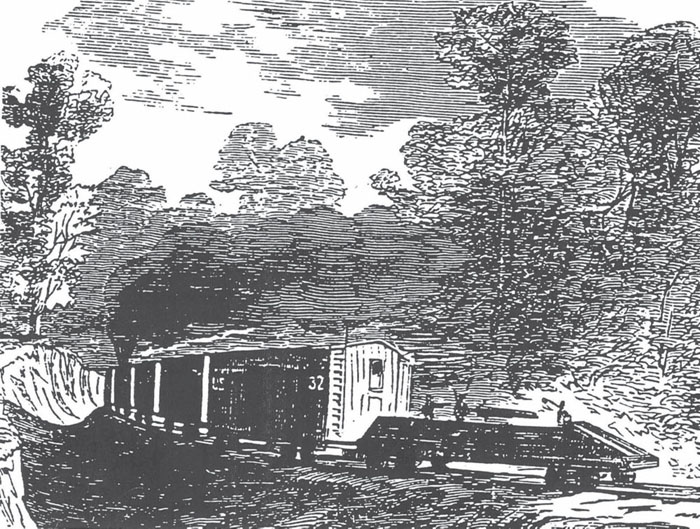
This armoured wagon precedes and protects its train with a gun mounted so as to allow virtual all-round fire. This arrangement on the other hand has the inconvenience of exposing the gun crew to hostile fire when loading or when using their small arms. The armour protection would probably be constructed using inclined rails fastened to a wooden structure.
(Engraving: Harper’s Weekly, 1862)
A close-up detail from an Andrew J Russell photo, showing the first train over the repaired Bull Run Bridge in the Spring of 1863, allows us a glimpse of an armoured artillery wagon, constructed on a twelve-stave railroad flatcar. Note the typical inset halfway up the armoured sides, and the gun emerging from hinged ports. It appears this was a two-gun wagon, so a similar piece would be mounted to fire from the front set of ports faintly visible in the photo (here probably trained to cover the opposite side of the track).
(Photo: Library of Congress)
The siege of Petersburg (June 1864–April 1865) saw the employment of railway artillery by the Union forces who wished to seize this strategic railroad centre where five major lines converged. The United States Military Railroad (USMR) which was by this time fully operational, deployed these weapons to such good effect that the Confederate Army was gradually cut off from outside aid. The town fell on 3 April 1865.
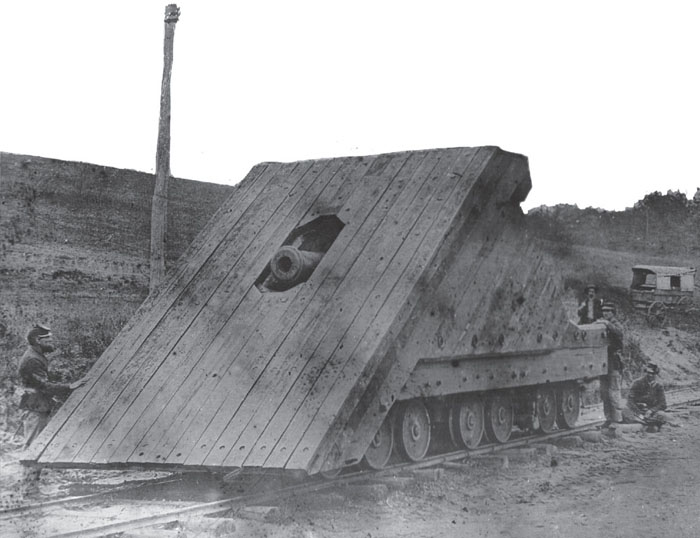
A 32pdr gun arms this battery used by the Union forces during the siege of Petersburg in 1864–5, mounted on seven axles. The use of wood for protection was widespread, and iron protection was much rarer.
(Photo: Library of Congress)
Alongside these units actually built, there existed a range of proposals put forward by enthusiastic citizens. For example, the project for a ‘travelling battery’ proposed by Charles Perley of New York, would have had the advantage of being able to move on rails (of different gauges) and on roads, the wheels being wide enough for these multiple roles. The inventor proposed to use such a wagon in front and to the rear of the engine. In the event of the wagon being uncoupled, the removable floor section would allow the crew to descend to rail or ground level and to push the vehicle, or even repair the tracks under cover. The armour protection was to consist of iron or steel plates fastened to a wooden frame. In addition to the light guns, firing loopholes were to pierce the sides, and four lengths of spare rail (marked No 4 on the plan) would be carried for track repair or replacement.
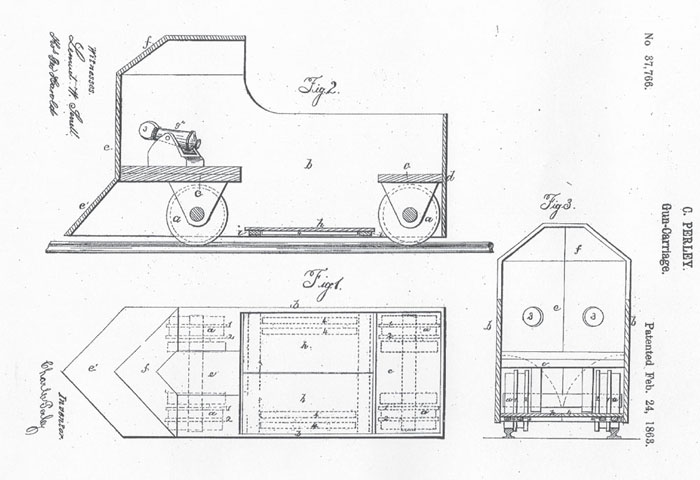
Plan attached to Patent 37.766, registered by Charles Perley, granted on 24 February 1863.
Prior to the opening of the Panama Canal, the railway line linking Colón (Aspinwall to the Americans) in the north of the isthmus with Panama City in the south was of great strategic importance. To counter the attacks on the railway infrastructure of the Panama Railroad Company by revolutionaries struggling against the Colombian Government, the United States decided to intervene by sending by sea a contingent of 740 men (two battalions of Marines and sailors used to handling Gatling guns). The troops landed at Panama on 7 April 1885 then at Colón on 15 April. Between these two dates, on the night of the 10th/11th, two armed and armoured wagons were built under the supervision of Lieutenant Kimball, US Navy. From the 11th onward, order was gradually restored, and normal railway traffic could recommence, now under the protection of the armoured wagons.
American armoured wagon in Panama.
(Engraving: Harper’s Weekly, 30 May 1885)
These wagons were armoured with steel plates 3ft 7¼in (1.10m) high and four-tenths of an inch (10mm) thick; each wagon was armed with a 37mm Hotchkiss QF gun, a short Gatling on its mounting, and a 12pdr smoothbore howitzer. The latter could be deployed in a ground role. The crew comprised forty-two US Marines and fifty-eight sailors.
In September 1902, the region was shaken by revolutionary movements, and in November 1903 a contingent of Marines and sailors landed once more, took up position in Colón and put into service armoured trains about which virtually no information is available.
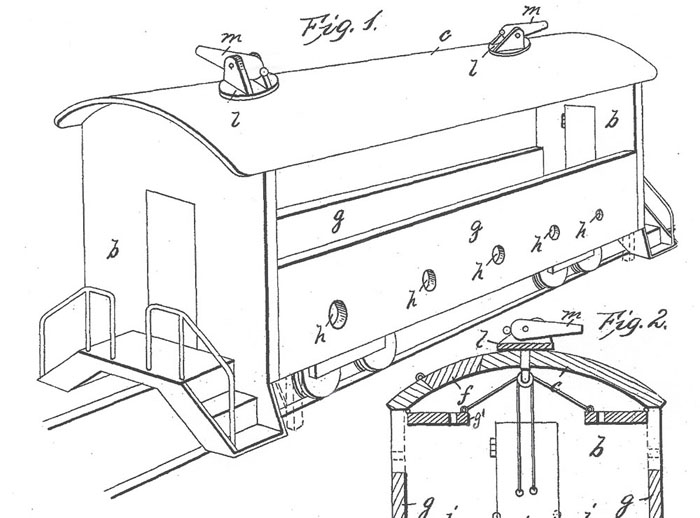
Engraving attached to Patent 540.134 of 28 May 1895.
In 1895, a native of Pennsylvania, a certain John Beck, obtained a patent for an armoured wagon armed with guns on the roof, aimed and fired by remote control. The upper halves of the armoured sides had panels which hinged upwards to allow salvo firing by the crew, while gunports in the lower halves allowed for firing small-calibre guns. Recoil was to be catered for by stabiliser legs at each corner of the vehicle. Surprising for such a late date, the small-calibre guns in the patent drawing would not have been out of place in the Civil War thirty years earlier. Probably the drawing was purely indicative, but they detract from the overall impression.
This tramcar converted into an armoured cruiser is purely anecdotal, and would have no place in the overall story of the armoured train had it not raised interest in the possible employment of such vehicles during civil disturbances.
To publicise the presidential election campaign of Republican candidate William McKinley in 1896, a tramcar had been converted into an armoured cruiser, using pasteboard according to some sources, or metal according to others. Designed by naval architect Henry P Lapointe, it was built and ran in the town of Fitchburg,3 Massachusetts. The idea originated with a supporters’ club who set up a company to participate in the election campaign, and elected as its ‘captain’, a certain Major Charles K Darling.4 The ‘warship’ was 37ft (11.28m) long, 9ft (2.74m) wide and 12ft (3.65m) high. It was powered by two 30hp electric motors. The basic idea was to show that it would be possible to construct an armoured vehicle on tramway rails to intervene in urban riots. It could also be used to rapidly and securely transport a body of troops up to company size, plus artillery, between towns. This idea would be revived again in 1938, when ‘a fleet of such trolleys, a new step in the progress towards mechanised warfare’ was suggested. After McKinley’s presidential election victory in 1896, certain sources indicate that the ‘armoured cruiser’ was put afloat on Lake Whalom, in a park belonging to the tramway company, while others claim it was left to fall to pieces.5
In 1899, shortly after the Spanish-American War, the Americans decide to take control of the former Spanish colonies. In the Philippines, the Nationalists, with their capital at Manolos, refused to accept what they considered a new colonial yoke, and took up arms against the American forces concentrated in Manila. The latter advanced along the railway, using an improvised armoured train initially armed with a naval 6pdr gun and two Gatling guns firing to the sides. This armament was later augmented by a Hotchkiss revolver cannon. Their advance on Manolos was delayed by several lines of resistance but the town was taken. The rebels changed their tactics and began attacking the railway behind the American lines. On 25 April 1899 the armoured train was in action at Calumpit, pushed by Chinese workmen, in support of 400 troopers of the 4th Cavalry fighting dismounted. During that battle, it seems the firepower of the train was a major factor in inducing the Filipinos to withdraw. The war dragged out in the mountains, and the armoured train having no further useful employment, the individual wagons were probably returned to civilian use at the end of 1899.
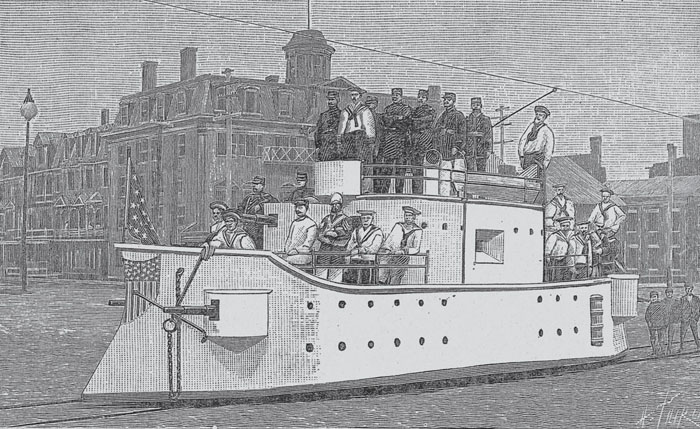
The tramcar, loosely inspired by the armoured cruiser USS Brooklyn, described as having a white hull, green superstructure (which in fact would have been buff yellow) and black armament and portholes.
(Engraving: La Nature No 1247 [24 April 1897], p 336)
We have no information on this American armoured train design, which is probably intended for coast defence given the similarity of its components to those of warships. Stated to be a project dating from 1898, it could in fact be a revival of the original project of 1845.
(Engraving: All Rights Reserved)
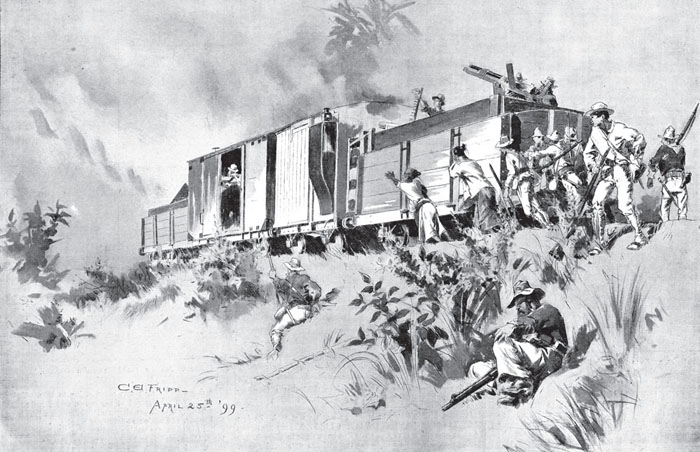
An engraving showing the armoured train, made up of four wagons, the leading wagon armed with a 37mm Hotchkiss revolver and a Gatling gun. In the absence of a steam engine, it was pushed by hand by Chinese labourers during the fighting on the Bagbag River during the Battle of Calumpit.
(Engraving: Paul Malmassari Collection)
In West Virginia, coal miners went on a long drawn-out strike, lasting from 18 April 1912 to the end of July 1913. On one side were some 8000 strikers, demanding equality of pay with miners from the surrounding areas, an end to the practice of compulsory purchase in the company shops, and regulated coal-weighing procedures. They faced 300 private guards from the notorious Baldwin-Felts Detective Agency, brought in by the mining companies, supported by 1200 Federal troops. In order to protect strikebreakers, the Agency guards organised the construction of an armoured train in the workshops of the C&O7 Railroad Company at Huntington. The train consisted of a steam engine, a passenger coach and a van protected by steel plates. On the night of 7 February 1913, in retaliation for an attack on an ambulance and the depot near Mucklow, this train was used in a raid by private detectives, policemen and mine operators led by Kanawha County Sheriff Bonner Hill. They fired a hundred rounds from a Colt machine gun into the timber-framed house of a striker, Cesco Estep, killing him and wounding several others.
Another dramatic incident took place during this period, when violent clashes broke out in Southern Colorado, in particular in a lengthy strike involving the coal mines owned by the Colorado Fuel & Iron Corporation, where the miners were stung by the murder of one of their number. On one occasion during a raid on the strikers’ tent encampment by guards recruited by the company, the miners improvised an armoured train, and used it to attack strike-breakers. The strike continued into the Spring of 1914 and ended in the ‘Ludlow Massacre’ in which twenty-six miners along with several women and children perished.8
Although not strictly speaking armoured, the train which had transported the Colorado Militia to attack the tent camp at Ludlow was deliberately halted by its driver in front of the Militia machine gun emplacements, thus covering the escape of many strikers and their families.
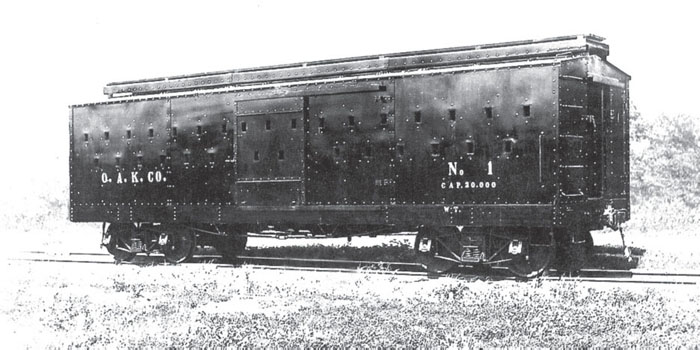
Orenstein Arthur Koppel Armoured Car No 1.
(Photo: All Rights Reserved)
In 1914 the US Division of the German firm Orenstein Arthur Koppel in Pittsburg built an armoured wagon with firing loopholes arranged in a quincunx layout, as used in the trains of the Boer War a dozen years earlier. As at that moment the US Army had no operational requirement for such a vehicle, it was probably sold to a foreign country, perhaps in South America.
After troops under Pancho Villa had massacred Americans on a civilian train, then carried out the raid against the town of Columbus, New Mexico, on 9 March 1916, the USA decided to send a force under the command of General Pershing to eliminate the guerrilla menace. For this operation, in 1916 the American Army acquired some thirty Mack-Saurer trucks, known as ‘Rikers’ (from the name of their designer Andrew Riker). Several would be converted for use on rails, but were employed only in supply missions on the railway networks in New Mexico and Texas, since the Constitutionalist Government had forbidden American forces to use the Mexican railways.
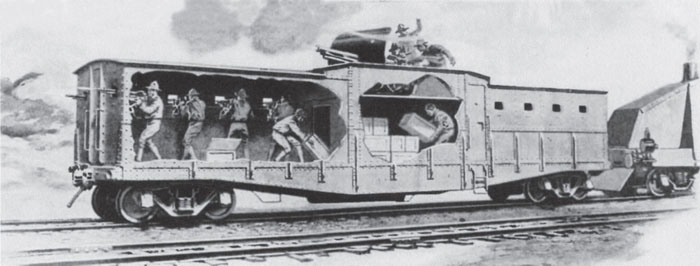
An artist’s impression showing the interior of the Standard Steel Co. patrol wagon. The machine guns shown here were the Machine Rifle Model of 1909 (Benet-Mercié Hotchkiss Portative), the unjustly maligned ‘Daylight Gun’ of the Pancho Villa raid on Columbus, New Mexico.
(Illustration: Popular Science Monthly Vol 89 [1916])

Side elevation and end view of the patrol wagon.
(Drawing: All Rights Reserved)
The hulls of these two armoured railcars have a similar roof layout and lower armour protection to the 1916 Standard Steel armoured wagon. The lack of vertical T-section straps on the sides and driving positions in each corner follow the arrangement of the Hall-Scott Type 11.001 railcar. The gun in the nearer of the two wagons is not the US 3in, but the Model of 1917 (the British 18pdr converted to fire French 75mm ammunition), which entered service in February 1918, and .30 Cal Browning MGs are mounted in the gun well. This armament would suggest a date in the 1920s, and the railcars could conceivably be retained for Mexican Border patrols. Note the smoke from the roof exhaust pipe. A coloured version of this photo was issued as cigarette card No 99 by Lloyd Zigaretten.
(Photo: El Paso Public Library)
The Board of Engineers of the American Army had noted the armoured wagons built by the Villa forces, including an armoured version of the Riker truck (see the chapter on Mexico). So to secure the Mexican border during the crisis, the Engineers designed an armoured wagon, and gave the contract to the Standard Steel Company, which turned out the vehicle in just twenty-seven days. Its mission was to defend the railway lines and the nearby installations, rather than carry out offensive raids. The armour provided protection against small-arms fire only, and it was pierced by twenty firing loopholes at standing height for light machine guns and rifles. The central part held a stock of ammunition in its lower level, and the upper part formed a firing position for a 3in (76mm) field gun, served by three gunners. On patrol, the crew totalled a dozen men, who were provided with benches, a toilet and a tank of drinking water. The whole wagon weighed 44 tons. Although the cutaway illustration from Popular Science Monthly shows the wagon being propelled by an armoured steam engine, in fact the latter was never built. An identical wagon mounting a searchlight was however built, and this was propelled by a rail trolley.
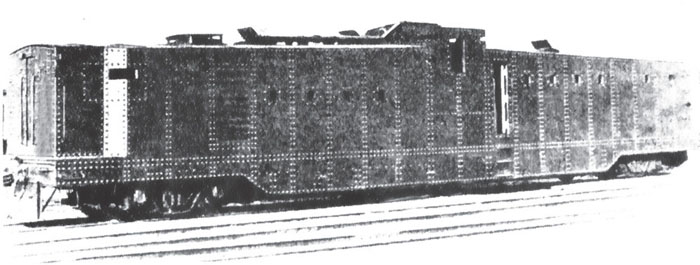
Similar in layout to the Standard Steel armoured wagon, but self-propelled and therefore more versatile, this is the Hall-Scott Type 11.001 Armoured Railcar. Note the driving positions at each corner, the centre of each end being taken up by a communicating armoured door when multiple units were coupled together.
(Photo: All Rights Reserved)
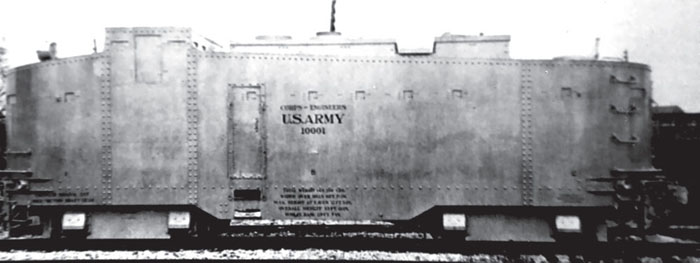
A second prototype armoured railcar was also commissioned by the US Army Corps of Engineers, and this time built by the General Electric Company. It is a more compact, traditional design, also mounted on bogies, but lacking a field gun.
(Photo: All Rights Reserved)
Drawing forming part of the patent granted to John Stankus on 5 October 1915.
Although the Americans only entered the First World War on 6 April 1917, several patents for armoured rail vehicles had been applied for since 1914, for example one by a certain Mr Bellamore of New York for a system of standardised armoured panels. In 1915, John Stankus of Pennsylvania proposed an armed and armoured road-rail vehicle. The conversion was effected by attaching rubber tyres on the rail wheels (US Patent 1,155,450). On 17 July 1918 Frederick W Wagner applied for a patent for an ambitious machine: armed with quick-firing guns, it travelled on the road, and was also equipped with tracks to cross wet ground. In addition, its wheels allowed it to travel on rails. The patent was granted on 21 January 1919, too late for the war, under Number US 1,292,170. It is illustrated below.

A more practical proposition, as planned in 1917. Note the curious representation of the machine guns.
(Drawing: All Rights Reserved)
In 1917, directives were issued laying down rules for the rapid conversion of armoured wagons in an emergency. The plan annexed to these proposals harked back to the wagons built during the Boer War, down to the roof-mounted searchlight and the arrangement of the firing loopholes in the armoured sides (drawing above).
Tractors for the 60cm gauge were built for service at the front, on the model of the British Simplex, and were used notably in the Meuse-Argonne offensive. They had a maximum speed of 8mph (12.9km/h) and a total weight of 6.35 tons.
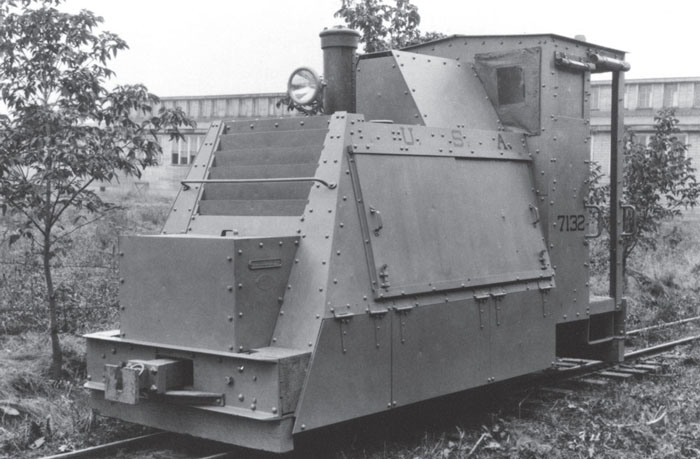
The prototype of the Baldwin MM8 armoured tractor.
(Photo: DeGolyer University)
Baldwin built 126 narrow gauge Type MM8 tractors, with an output of 50hp, for use by the American army in France, but apparently only one example was armoured.
In 1919, the Americans intervened alongside the other Allies against Bolshevik Russia. The American Expeditionary Force (AEF) was in action in the Murmansk region where, to protect the rail network, it put into service at least one armoured train.
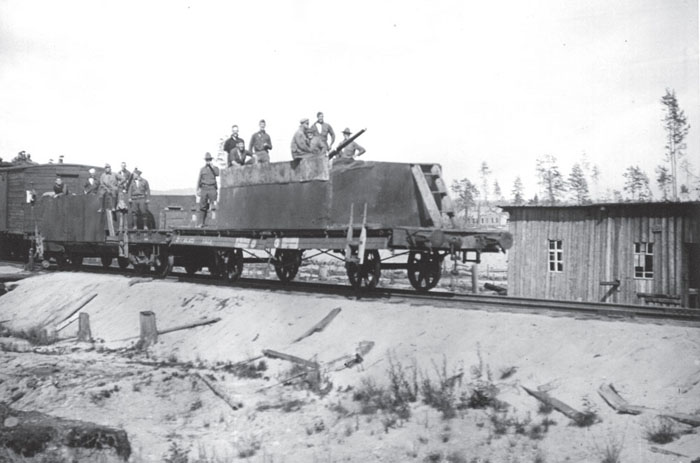
An improvised armoured train used by the American contingent in Russia in 1920.
(Photo: IWM)
The page from the Lionel Catalogue of 1917. The turret guns were fitted with red lights which flashed as the turret was turned.
(Catalogue Page: via Bill Schmeelk of The Lionel Collectors’ Club of America)
Armoured trains featured prominently in the popular press during the early years of the First World War, so it was inevitable that an electric train set would be produced by the Lionel Company. The set complete with armoured locomotive (which presaged the form of the Crochat armoured tractors which would appear a year later) was first offered in the Lionel Catalogue of 1917, and remained on sale through 1919. It has recently been reissued by a modern American manufacturer.
During the Second World War, the Americans did not use armoured trains in an offensive role. On the other hand, they did employ passive protection, particularly on locomotives. Certain Whitcomb 65-DE-14 diesel locomotives were armoured, being the units deployed to the North African theatre (nineteen in 1942 and seventeen in early 1943). In all, in order to provide protection against air attack, fifty complete sets of armour were ordered from Whitcomb, to protect the driving cab and the ends of the machine.
Although the Americans did not use armoured trains (the special armoured coach built by the LNER for General Eisenhower is described in the chapter on Great Britain), armoured trains remained part of popular imagination, and continued to appear in toy form. Metal being in demand for war construction, card cutouts became very popular, as shown by this sheet issued in February 1941. Even if it is not based on any specific prototype, the camouflage scheme of green and earth upper surfaces is very British!
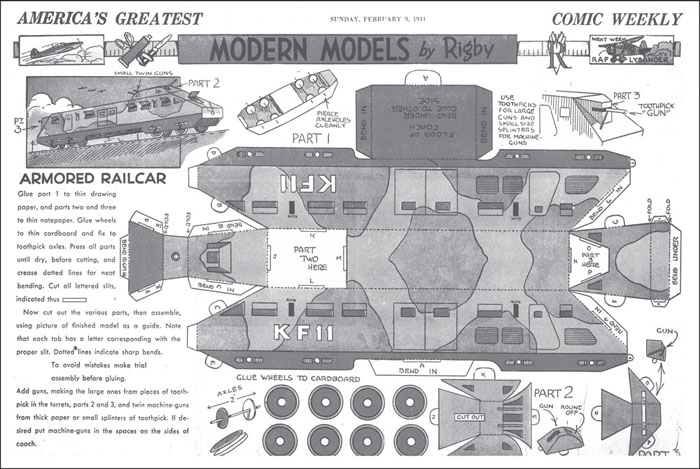
The card model from February 1941.
(Sheet: Paul Malmassari Collection)
Characteristic of the Cold War Period is the ‘White Train’ designed for the transport of nuclear material. The Safe Secure Railcar (SSR) wagons were built by the Thrall Car Company of Chicago, Illinois, by reinforcing and armouring modified bogie wagons. Design studies began in the 1950s and took two years to complete. Built initially for the transport of nuclear weapons, the older wagons were later used to carry military nuclear waste from the Rocky Flats site in Colorado to an underground repository in Idaho.
Eighty-three of the ATMX 500 Series were built, followed by fourteen ATMX 600 Series. They possessed several security measures to prevent terrorists from gaining access to the cargo. The inclined shape of the wagon ends is intended to minimise the results of a collision, by allowing the end of one wagon to slide up over the rear of the preceding one. Overall structural strength was also enhanced by the fact that loading took place through openings in the roof which were closed by riveted plates.
Running in complete designated rakes and not coupled in commercial trains, the nuclear wagons formed an armoured train rolling at up to 35mph (55km/h), stopping only to refuel the locomotives, and protected by armed guards aboard wagons at each end. The normal configuration was: locomotive/escort wagon/shock-absorbing wagon/nuclear munitions transport wagon/shock-absorbing wagon/escort wagon. Empty wagons would be coupled in with the loaded ones. The crew had at their disposal HF, VHF and CB Band radio equipment, and remained in constant communication with a network of intervention teams. The employment of each train was the responsibility of the Operations Bureau of the DOE (Department of Energy) in Albuquerque, which also controlled road movements. The eleven surviving wagons were preserved at the National Atomic Museum on Kirtland Air Base near Albuquerque, before being transferred to the Amarillo Railroad Museum.
Technical details (ATMX-600 Series)
| Length: | 59ft 10in (18.24m) |
| Width: | 10ft 0in (3.05m) |
| Height: | 13ft 10in (4.22m) |
| Carrying capacity: | 45.95 tons |
| Loaded weight: | 99.79 tons |
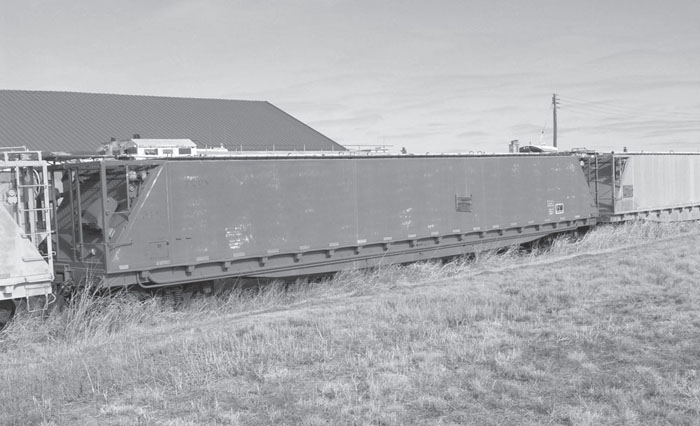
Nuclear Weapons Transport Car TSSX 557.
(Photo: Amarillo Railroad Museum)
Armoured Escort Wagon TSSX G-33, showing its openings, firing loopholes and radio antenna.
(Photo: Amarillo Railroad Museum)
For the sake of completeness, we need to mention certain special armoured rail vehicles, such as the presidential carriage Ferdinand Magellan, converted and armoured for President Franklin D Roosevelt, or armoured postal or cash transfer wagons, an American speciality which was the subject of many Patents between the late nineteenth and early twentieth centuries. Below is just one example, taken from 1888, which bears more than a passing resemblance to certain military contemporaries.
In 1919, a newspaper article described one of these protection wagons in great detail, probably to dissuade potential hijackers. At right we see a guard firing a pump-action shotgun, as used by prison guards, through an armoured embrasure. The same article was even copied in 1924 in a popular French review!
Finally, we note that an armoured railcar was put into service on the Metroliner network, but we have no details concerning it.
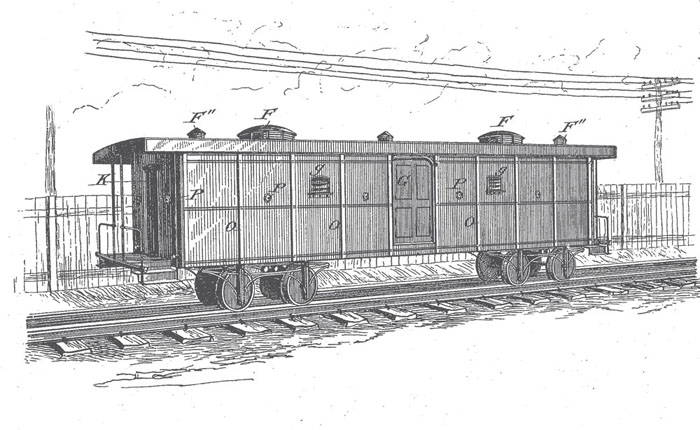
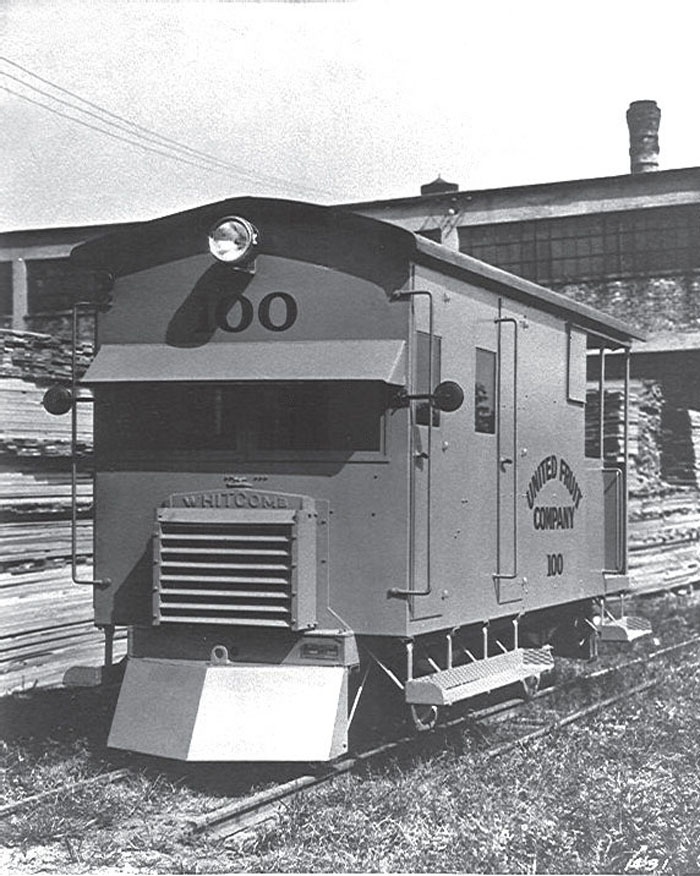
Armoured Whitcomb railcar belonging to the United Fruit Company, built in 1928 .
(Photo: All Rights Reserved)
SOURCES
Archives:
DeGoyler Library
Library of Congress
US National Archives
US Patents Office
Books:
Alexander, Edwin P, Civil War Railroads & Models (New York: Clarkson N. Potter, Inc./Publishers 1977).
Drumm, Nelde K, and Harley, Margaret P, Lunenburg – The Heritage of Turkey Hills 1718-1978 (Lunenburg, MA: Lunenburg Historical Society, 1977).
Heimburger, Donald J, and Kelly, John, Trains to Victory: America’s Railroads in WWII (Forest Park, IL: Heimburger House Publishing Co, 2009). 380 pages.
Hodges, Robert R Jr., American Civil War Railroad Tactics (Oxford: Osprey Publishing, 2009).
Koenig Alan R, Ironclads on Rails: Railroad Weapons of the American Civil War, 1861-65, Doctoral History Thesis, University of Nebraska-Lincoln (E-U.), under the supervision of Dr Edward Homze, 1995.
Journal articles:
Hall, James D., ‘Armored Trolley’, Railroad Magazine (1938), pp 93–4.
Stanitz, Jim, and Moon, Paul F, ‘Safe Secure Rail Cars’, NMRA Bulletin (September 1980), pp 33–4.
Waite, Thornton, ‘ATMX Covered Hoppers, a Special Car for Nuclear Shipments’, Mainline Modeler (August 2001), pp 69–72.
Walsh, Paul V, ‘A US Armoured Train in the Philippines, 1899-1900’, AFV News 28/2 (May-August 1993), pp 10–11.
‘A Trolley Man-of-War’, Literary Digest Vol XIV, No 10 (9 January 1897), pp 304–5.
‘Emploi de l’artillerie sur un chemin de fer pour la défense des côtes [des USA]’, Journal des sciences militaires No 66, Third Series, Vol XXII (1845), p 304.
‘Our First Armored Car’, Popular Science Monthly Vol 89 (1916), pp 388–9.
‘Parades américaines, un navire de guerre à trolley’, La Nature No 1247 (24 April 1897), p 336.
‘Trains blindés d’Amérique’, Lecture pour tous (November 1924), pp 180–2.
‘Trains, Boats and Guns–Armour in Panama, 1885’, Tank TV No 23 (September 2000), pp 1–4.
Papers on Naval Operations, Chapter II, Navy Department, 1885.
Fitchburg Daily Sentinel, 11 September 1896
Harper’s Weekly, 1862.
Harper’s Weekly, Vol XXIX, No 1484 (30 May 1885), p 349.
Metal Trades (February 1919), pp 94–5.
Modern Mechanics (February 1919).
Websites:
www.youtube.com/watch?feature=player_detailpage&v=kz54FcA4wqA
1. ‘Emploi de l’artillerie sur un chemin de fer pour la défense des côtes [des USA]’, Journal des sciences militaires No 66, Third Series, Vol XXII (1845), p 304.
2. Who, from his famous side whiskers, popularised the fashion of ‘sideburns’.
3. By the Fitchburg & Leominster Street Railway Company.
4. The Fitchburg Daily Sentinel, 13 and 21 August 1896, p 6.
5. All the sources consulted remain quite vague, but it is not the job of journalists to record history.
6. So named from the mine owners’ links with the Progressive Party of West Virginia, known as the ‘Bull Moose Party’ after the popular nickname of presidential candidate Theodore Roosevelt.
7. The Chesapeake & Ohio Railroad, founded in 1869.
8. Some sources quote a total of sixty-six deaths.